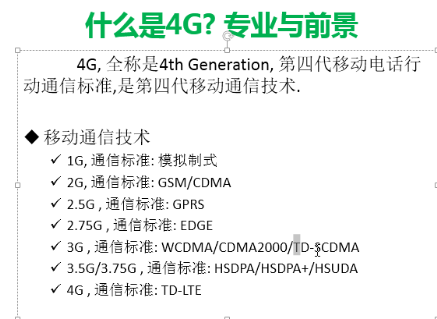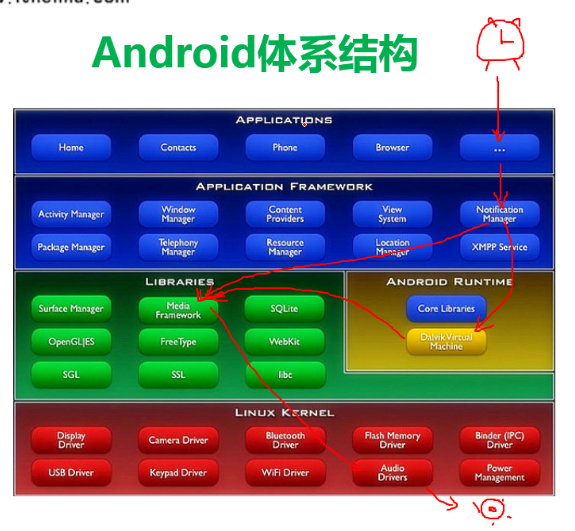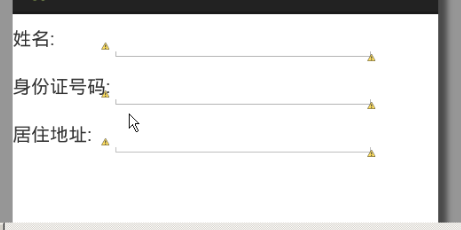android 55

智能家居:可以联网可以用指令操作可以返回状态。智能微波炉智能眼镜智能手表。
Android作者Andy Rubin,2007年正式由谷歌推广,开源的。
安卓体系结构和开发一个闹钟的调用结构图:

安卓和ios都是基于linux内核开发的。
开发工具:
Eclips+ADT,
Intel模拟器加速器虚拟化cpu提高模拟器的速度,可以提高十多倍。
- System.out.println("hahahah,我被点击了.");打印到logCat控制台。
- #Android体系结构
- * 底层Linux操作系统
- * library c/c++的函数库
- * 应用程序框架层 java提供的函数库
- * 应用程序
- #jvm和dvm的区别
- * 版权问题
- * 效率问题
- #下载Android开发的sdk
- * 什么是sdk
- > standard develop kits 标准开发工具集
- 下载选择32位或者64位的版本
- 直接解压下载下来的zip包
- #Android sdk的目录结构
- * eclipse 开发工具ide 订制版本的eclipse
- * sdk 开发工具集合
- * SDK Manager.exe sdk管理器,提供sdk的更新
- #sdk文件夹的目录结构(打开SDK Manager.exe看到的)
- * Extras 额外的工具
- * Android support library 向下兼容提供的函数库
- * Google usb driver 真实手机的驱动(只有谷歌的亲儿子才可用 nexus s)
- * intel HAM intel的硬件加速(只有是intel的处理器,adm处理器不可用)
- * 模拟器要想在电脑上运行需要有系统的镜像
- * arm system image (arm系统平板,在电脑上模拟运行速度比较慢)
- * x86 system image (x86电脑处理器,在电脑上模拟运行速度比较快)
- * doc 离线文档(包含全部的api的说明)
- * platforms 不同版本sdk的开发android.jar包
- * platform-tools 平台工具
- * adb.exe Android debug bridge(安卓开发调试桥)
- * dx.bat 把.class的字节码转化成.dex的字节码
- * samples 开发用的示例代码
- * sources sdk的全套源码
- * system-images 系统镜像
- * tools 模拟器的应用程序就存放在这个文件夹里面
- ##强烈推荐使用4.1.2版本的模拟器.最稳定.
- ##千万不要使用4.2版本的模拟器,bug非常多
- ##常见分辨率
- * VGA 640x480
- * HVGA 480x320
- * QVGA 320x240
- * WVGA 800x480
- * FWVGA 854x480
- ##模拟器名称
- *5554 端口号 一个模拟器占用两个端口号
- ##DDMS
- * dalvik debug manager system
- ##ADT
- >Android Developer Tools 安卓开发工具集(eclipse的一个插件)
- >21.1.0.v20130206 不要升级adt的版本
- >会帮着我们自动创建Android的工程结构,帮我们编译应用程序-->生成apk--->部署手机-->运行
- ##Android工程磁盘的目录结构
- * .settings eclipse创建的文件夹 记录工程的配置信息
- * assets 资产目录 打包一些文件到应用程序里面(数据库文件,网页文件,配置文件,图片)
- * bin eclipse编译的二进制文件,把java-->class--->dex-->res打包-->.apk,apk是zip文件,可以把后缀名改为zip后用解压缩软件打开。
- * gen 自动生成的代码
- * libs android-support-v4.jar 安卓的支持jar包
- * res 应用程序的资源目录 图标 文本 颜色资源
- * drawable 存放应用程序的图片资源
- * layout 存放应用程序的布局文件 xml文件
- *
- * src 我们编写的java代码
- * .classpath eclipse配置文件
- * .project eclipse配置文件
- * manifest.xml 非常重要是应用程序的清单文件 配置应用程序的版本号,图标,名称
- * project.properties 工程的配置文件
- ##Android应用程序开发的步骤
- 1. 创建工程,配置应用程序工程名称,包名,图标.
- 2. 编写应用程序的ui界面, res-->layout--->main_activity.xml
- > 布局都是xml文件编写的,支持图形化的拖拽
- 3. 写java代码.在src目录下 MainActivity.java
- @Override
- protected void onCreate(Bundle savedInstanceState) {
- super.onCreate(savedInstanceState);
- //设置应用程序显示的界面
- setContentView(R.layout.activity_main);
- //TODO:查找我们关心的控件,实现控件的点击事件
- }
- 4. 必须给关心的控件设置id. 这个id会在R.java文件里面生成一个引用
- 5. 在java代码 findViewById(R.id.xxxx);
- 6. 设置控件的点击事件
- bt_click.setOnClickListener(new MyButtonListener());
- 7. 打印土司
- Toast.makeText(MainActivity.this, "hahahah,我被点击了.", Toast.LENGTH_SHORT).show();
- ##应用程序编译安装的过程(磁盘里面查看).
- 一. 把所有的.java文件编译成.class文件 ,bin/class文件夹下面
- > jdk 的 javac.exe
- 二. 把所有的.class字节码文件打包合成一个文件 classes.dex
- > sdk中的dx.bat文件 把.class -->.dex
- 三. 根据资源的id,生成一个资源文件resources.ap_ 保存全部的资源文件的信息
- 四. 把.dex文件,res目录下的资源文件,resources.ap_的引用, asset目录下的文件
- 合成在一起打成一个apk的压缩包
- >使用的是 aapt.exe
- 五. adb.exe 负责把生成好的apk文件上传安装到手机里面.
- > Android debug bridge 安卓调试桥,负责上传安装apk
- ##常见的adb命令
ctrl+shift+鼠标右键:快速打开命令行窗口。
路径加入环境变量是在path里面添加adb.exe的路径。
- * 安装一个应用程序
- > adb install xxx.apk
- * 卸载一个应用程序
- > adb uninstall com.itheima.clickme<包名>
- * 进入到手机终端里面
- > adb shell
- > 进入手机终端之后就可以执行Linux命令 kill 杀死一个进程 ps 列出来进程 ls 列出来文件
- * 杀死adb的调试桥
- >adb kill-server
- >adb的调试桥不稳定,经常掉线,如果掉线了,执行adb kill-server把调试桥杀死
- * 启动adb的调试桥
- >adb start-server
- * 查看连接在电脑上的设备
- >adb devices
- >adb start-server这个方法比较笨,如果一次启动不成功,就不启动了.通常使用adb devices来代替adb start-server
- * 指定设备执行adb指令
- >adb -s emulator-5556 install xxx.apk
- ##URI && URL
- * URL 统一资源定位符(网址,ftp,rtsp)
- > http://www.baidu.com
- > http://www.itheima.com
- * URI 统一资源标识符(范围更加广泛)
- > tel://110
- > content://
- ##权限模型的目的,例如拨打电话权限:
- <uses-permission android:name="android.permission.CALL_PHONE"/>
- * 给用户一个提醒,让用户知道你安装的软件需要干什么操作.
- * 只有敏感操作才需要申请权限(钱,设备安全,隐私)
- * 避免潜在法律诉讼
- ##点击事件的四种写法
- * 内部类
- * 匿名内部类
- * 让activity实现onclickListener接口
- * 在布局xml文件里面绑定点击事件
- ##常见的布局
- * LinearLayout 线性布局
- > 线性布局的朝向 vertical|horizontal
- > 线性布局的权重 weight 和 0dip一起使用
- * RelativeLayout 相对布局 都是按照相对位置排列的
- * FrameLayout 帧布局
- > 布局层层叠加覆盖的
- > DIV
拨打电话:
- private class MyButtonListener implements OnClickListener{
- @Override
- public void onClick(View v) {
- //2.当用户点击按钮的时候 获取里面的电话号码
- String phone = et_phone.getText().toString().trim();
- if("".equals(phone)){//LENGTH_SHORT时长
- Toast.makeText(MainActivity.this, "电话号码不能为空", Toast.LENGTH_SHORT).show();
- }else{
- //拨打电话....调用系统的应用程序让系统帮我们拨打电话.
- //机器打孔-->汇编语言(要对处理器非常了解)-->c语言-->c++(有内存泄漏问题) -->java(c+++)--->c#(++++)---> 第五代编程语言(自然语言)
- //1.创建一个意图对象. 打(action) 贱人(data) 泡(action)红茶(data)
- Intent intent = new Intent();
- //dail是启动拨号界面, call直接拨打号码
- intent.setAction(Intent.ACTION_CALL);//设置动作action, 拨打电话
- //3.指定动作的数据
- intent.setData(Uri.parse("tel://"+phone));//parse将字符串转换为Uri
- //调用系统播发电话
- startActivity(intent);
- }
- }
- }
- 系统描述文件:
- <uses-permission android:name="android.permission.CALL_PHONE"/> permission是权限节点
- 点击事件:
- <!-- 只要在布局文件指定了onclick的属性,
- 代表就是当这个按钮被点击的时候,会执行activity里面的方法
- 方法名 haha -->
- <Button
- android:onClick="gaga"
- android:layout_width="wrap_content"
- android:layout_height="wrap_content"
- android:layout_alignParentLeft="true"
- android:layout_below="@+id/button1"
- android:layout_marginTop="40dp"
- android:text="按钮02" />
- //点击事件的第四种写法 直接在布局xml文件里面指定点击事件的方法名
- public void gaga(View view){
- Toast.makeText(MainActivity.this, "嘎嘎", 0).show();
- }
相对布局:

- <?xml version="1.0" encoding="utf-8"?>
- <RelativeLayout xmlns:android="http://schemas.android.com/apk/res/android"
- android:layout_width="match_parent"
- android:layout_height="match_parent" >
- <Button
- android:id="@+id/bt_middle"
- android:layout_width="wrap_content" 宽度为包裹内容
- android:layout_height="wrap_content"
- android:layout_centerHorizontal="true" 父窗口水平居中
- android:layout_centerVertical="true" 父窗口垂直居中
- android:text="中间" />
- <Button
- android:id="@+id/up"
- android:layout_width="wrap_content"
- android:layout_height="wrap_content"
- android:layout_above="@id/bt_middle" 在"中间"按钮的上方
- android:layout_centerHorizontal="true" 水平居中
- android:text="上" />
- <Button
- android:id="@+id/down"
- android:layout_width="wrap_content"
- android:layout_height="wrap_content"
- android:layout_below="@id/bt_middle" 在"中间"按钮的下方
- android:layout_centerHorizontal="true" 水平居中
- android:text="下" />
- <Button
- android:id="@+id/left"
- android:layout_width="wrap_content"
- android:layout_height="wrap_content"
- android:layout_centerVertical="true" 水平居中
- android:layout_toLeftOf="@id/bt_middle" 在"中间"按钮的左方
- android:text="左" />
- <Button
- android:id="@+id/right"
- android:layout_width="wrap_content"
- android:layout_height="wrap_content"
- android:layout_centerVertical="true" 水平居中
- android:layout_toRightOf="@id/bt_middle" 在"中间"按钮的右方
- android:text="右" />
- <Button
- android:layout_above="@id/left"
- android:layout_toLeftOf="@id/up"
- android:layout_width="wrap_content"
- android:layout_height="wrap_content"
- android:text="左上" />
- <Button
- android:layout_below="@id/left" left下面
- android:layout_toLeftOf="@id/up" up左边
- android:layout_width="wrap_content"
- android:layout_height="wrap_content"
- android:text="左下" />
- <Button
- android:layout_above="@id/right"
- android:layout_toRightOf="@id/up"
- android:layout_width="wrap_content"
- android:layout_height="wrap_content"
- android:text="右上" />
- <Button
- android:layout_below="@id/right"
- android:layout_toRightOf="@id/up"
- android:layout_width="wrap_content"
- android:layout_height="wrap_content"
- android:text="右下" />
- <Button
- android:layout_alignParentTop="true" 父亲的顶部对其
- android:layout_width="fill_parent" 宽度为填充父窗口
- android:layout_height="wrap_content" 高度为包裹内容
- android:text="顶部" />
- <Button
- android:layout_alignParentBottom="true"
- android:layout_width="fill_parent"
- android:layout_height="wrap_content"
- android:text="底部" />
- <Button
- android:layout_marginTop="45dip" 与顶部距离
- android:layout_marginBottom="45dip" 与底部距离
- android:layout_alignParentLeft="true" 与parent左边对其
- android:layout_width="60dip"
- android:layout_height="fill_parent" 高度填充父窗体
- android:text="左边" />
- <Button
- android:layout_marginTop="45dip"
- android:layout_marginBottom="45dip"
- android:layout_alignParentRight="true" 与parent右边对其
- android:layout_width="60dip"
- android:layout_height="fill_parent"
- android:text="右边" />
- </RelativeLayout>
桢布局:FrameLayout 帧布局,布局层层叠加覆盖的

- <?xml version="1.0" encoding="utf-8"?>
- <FrameLayout xmlns:android="http://schemas.android.com/apk/res/android"
- android:layout_width="match_parent"
- android:layout_height="match_parent"
- android:background="#ff0000" > 布局背景颜色为红色
- <TextView 将会覆盖上面的桢布局
- android:layout_gravity="center" 对其方式居中对其,水平垂直居中对其
- android:layout_width="200dip"
- android:layout_height="200dip"
- android:background="#00ff00" />
- <TextView
- android:layout_gravity="center"
- android:layout_width="100dip"
- android:layout_height="100dip"
- android:background="#0000ff" />
- <TextView
- android:layout_gravity="center"
- android:layout_width="50dip"
- android:layout_height="50dip"
- android:background="#ff00ff" />
- <TextView
- android:layout_gravity="center"
- android:layout_width="20dip"
- android:layout_height="20dip"
- android:background="#ffff00" />
- </FrameLayout>
绝对布局:
- <?xml version="1.0" encoding="utf-8"?>
- <AbsoluteLayout xmlns:android="http://schemas.android.com/apk/res/android"
- android:layout_width="match_parent"
- android:layout_height="match_parent" >
- <Button
- android:id="@+id/button1"
- android:layout_width="wrap_content"
- android:layout_height="wrap_content"
- android:layout_x="36dp"
- android:layout_y="222dp"
- android:text="Button" />
- <TextView
- android:id="@+id/textView1"
- android:layout_width="wrap_content"
- android:layout_height="wrap_content"
- android:layout_x="48dp"
- android:layout_y="95dp"
- android:text="Large Text"
- android:textAppearance="?android:attr/textAppearanceLarge" />
- </AbsoluteLayout>
表格布局:

- <?xml version="1.0" encoding="utf-8"?>
- <TableLayout xmlns:android="http://schemas.android.com/apk/res/android"
- android:layout_width="fill_parent" 宽度填充父窗体和match_parent一样
- android:layout_height="match_parent" >
- <TableRow 一行
- android:layout_width="match_parent"
- android:layout_height="wrap_content" > 高度为包裹的内容,里面控件有多高就多高
- <TextView 第一列
- android:layout_width="wrap_content" 宽度为包裹内容
- android:layout_height="wrap_content"
- android:text="姓名:" />
- <EditText 第二列
- android:layout_width="200dip"
- android:layout_height="wrap_content" />
- </TableRow>
- <TableRow 二行
- android:layout_width="match_parent"
- android:layout_height="wrap_content" >
- <TextView
- android:layout_width="wrap_content"
- android:layout_height="wrap_content"
- android:text="身份证号码:" />
- <EditText
- android:layout_width="200dip"
- android:layout_height="wrap_content" />
- </TableRow>
- <TableRow
- android:layout_width="match_parent"
- android:layout_height="wrap_content" >
- <TextView
- android:layout_width="wrap_content"
- android:layout_height="wrap_content"
- android:text="居住地址:" />
- <EditText
- android:layout_width="200dip"
- android:layout_height="wrap_content" />
- </TableRow>
- </TableLayout>
android 55的更多相关文章
- Android 6.0一个完整的native service
上一篇博客<Android 6.0 如何添加完整的系统服务(app-framework-kernel)>http://www.cnblogs.com/hackfun/p/7418902. ...
- Android零基础入门第55节:ImageSwitcher和TextSwitcher使用
原文:Android零基础入门第55节:ImageSwitcher和TextSwitcher使用 上一期我们了解了ViewAnimator组件和ViewSwitcher组件的使用,你都掌握了吗?本期一 ...
- 55.Android之AsyncTask介绍 (转)
AsyncTask和Handler对比 1 ) AsyncTask实现的原理,和适用的优缺点 AsyncTask,是android提供的轻量级的异步类,可以直接继承AsyncTask,在类中实现异步操 ...
- android学习笔记55——ContentProvider_2
实现ContentProvider 创建ContentProvider的步骤: 1.开发一个ContentProvider的子类,该子类需要实现增.删.改.查等方法: 2.在AndroidMainfe ...
- 【Android Developers Training】 55. 序言:高效显示位图
注:本文翻译自Google官方的Android Developers Training文档,译者技术一般,由于喜爱安卓而产生了翻译的念头,纯属个人兴趣爱好. 原文链接:http://developer ...
- 55、Android网络图片 加载缓存处理库的使用
先来一个普通的加载图片的方法. import android.annotation.SuppressLint; import android.app.Activity; import and ...
- Android(java)学习笔记55:LayoutInflater 和 findViewById
1. 在实际开发中LayoutInflater这个类还是非常有用的,它的作用类似于findViewById(). 不同点是LayoutInflater是用来找res/layout/下的xml布局文件, ...
- 55、android app借助友盟实现微信授权登录
一.去微信开放平台的管理中心申请移动设备的审核(需进行开发者资质认证,每年300元) 1.获取应用的签名 2.在微信开放平台申请移动应用 两个注意点:①签名要填对 ②应用的包名要写对(tips: co ...
- Gradle 实现 Android 多渠道定制化打包
Gradle 实现 Android 多渠道定制化打包 版权声明:本文为博主原创文章,未经博主允许不得转载. 最近在项目中遇到需要实现 Apk 多渠道.定制化打包, Google .百度查找了一些资料, ...
随机推荐
- 帝国cms在任意位置调用指定id的栏目名称和链接
注意,这个代码无须放在灵动标签中,直接写入模板相应的位置就行了.[1]调用栏目名称: <?=$class_r[栏目ID]['classname']?> 示例:<?=$class_ ...
- C#Winform开发平台企业版V4.0功能表
企业版V4.0 - 功能列表及模板窗体 C/S系统开发框架-企业版 V4.0 (Enterprise Edition) 简介: http://www.csframework.com/cs-framew ...
- 精通 Oracle+Python,第 3 部分:数据解析
进行数据解析的理由不计其数,相关的工具和技巧也同样如此.但是,当您需要用这些数据做一些新的事情时,即使有“合适的”工具可能也是不够的.这一担心对于异类数据源的集成同样存在.用来做这项工作的合适工具迟早 ...
- Python 学习之urllib模块---用于发送网络请求,获取数据(2)
接着上一次的内容. 先说明一下关于split()方法:它通过指定分隔符对字符串进行切片,如果参数num 有指定值,则仅分隔 num 个子字符串(把一个字符串分割成很多字符串组成的list列表) 语法: ...
- debug(fmt,args...)调试
1.定义宏(debug.h) #ifndef __DEBUG__H #define __DEBUG__H #include <stdio.h> #ifdef DEBUG #define d ...
- Java实现Http服务器(四)
(1)HTTPServer的监听启动 sun.net.httpserver.ServerImpl类中启动了Socket监听,ServerImpl的内部类Dispatch类启动了Http服务器的监听 / ...
- win32画线考虑去锯齿
整理日: 2015年2月16日 这几天一直在研究win32 SDk下画线去锯齿,之前一直用的QT的画线接口函数,里面有去锯齿的效果,可是突然项目要求不能用QT的只能用win32 SDK下的GDI画线接 ...
- server-send event object
http://jamie-wang.iteye.com/blog/1849193 event -- onmessage, onopen, onerror 不是方法,而是事件 http://school ...
- 你真的了解 MySQL 数据库的运行状况吗?
2015年第三方市场调查机构 Evans 数据公司最近公布的一系列客户调查数据显示,在过去两年里,MySQL 在所有开发者使用的数据库中获得了25%的市场份额,Evans 公司的本次调查显示,数据库的 ...
- 大数据计算新贵Spark在腾讯雅虎优酷成功应用解析
http://www.csdn.net/article/2014-06-05/2820089 摘要:MapReduce在实时查询和迭代计算上仍有较大的不足,目前,Spark由于其可伸缩.基于内存计算等 ...
